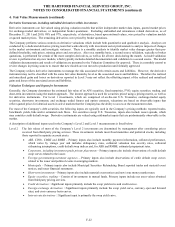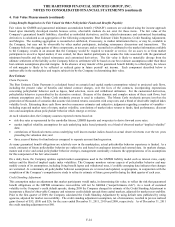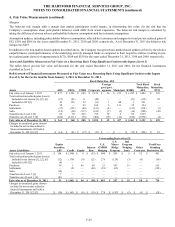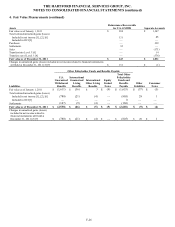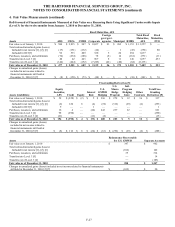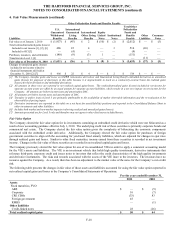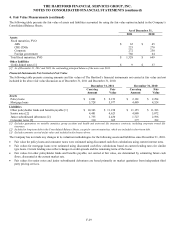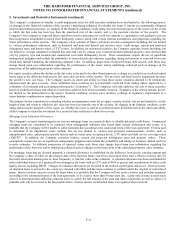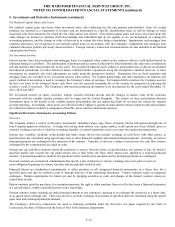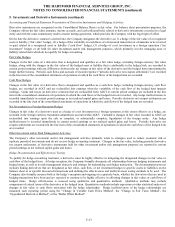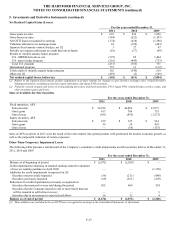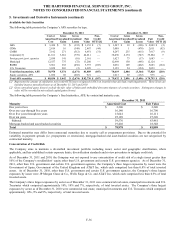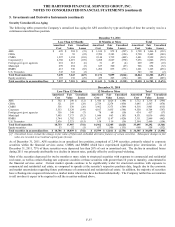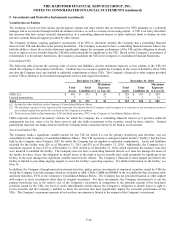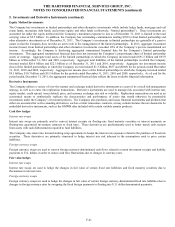The Hartford 2011 Annual Report Download - page 167
Download and view the complete annual report
Please find page 167 of the 2011 The Hartford annual report below. You can navigate through the pages in the report by either clicking on the pages listed below, or by using the keyword search tool below to find specific information within the annual report.THE HARTFORD FINANCIAL SERVICES GROUP, INC.
NOTES TO CONSOLIDATED FINANCIAL STATEMENTS (continued)
F-32
5. Investments and Derivative Instruments (continued)
Net Realized Capital Gains and Losses
Net realized capital gains and losses from investment sales, after deducting the life and pension policyholders’ share for certain
products, are reported as a component of revenues and are determined on a specific identification basis, as well as changes in value
associated with fixed maturities for which the fair value option was elected. Net realized capital gains and losses also result from fair
value changes in derivatives contracts (both free-standing and embedded) that do not qualify, or are not designated, as a hedge for
accounting purposes, and the change in value of derivatives in certain fair-value hedge relationships. Impairments and mortgage loan
valuation allowances are recognized as net realized capital losses in accordance with the Company’ s impairment and mortgage loan
valuation allowance policies previously discussed above. Foreign currency transaction remeasurements are also included in net realized
capital gains and losses.
Net Investment Income
Interest income from fixed maturities and mortgage loans is recognized when earned on the constant effective yield method based on
estimated timing of cash flows. The amortization of premium and accretion of discount for fixed maturities also takes into consideration
call and maturity dates that produce the lowest yield. For securitized financial assets subject to prepayment risk, yields are recalculated
and adjusted periodically to reflect historical and/or estimated future repayments using the retrospective method; however, if these
investments are impaired, any yield adjustments are made using the prospective method. Prepayment fees on fixed maturities and
mortgage loans are recorded in net investment income when earned. For limited partnerships and other alternative investments, the
equity method of accounting is used to recognize the Company’ s share of earnings. For impaired debt securities, the Company accretes
the new cost basis to the estimated future cash flows over the expected remaining life of the security by prospectively adjusting the
security’ s yield, if necessary. The Company’ s non-income producing investments were not material for the years ended December 31,
2011, 2010 and 2009.
Net investment income on equity securities, trading, includes dividend income and the changes in market value of the securities
associated with the variable annuity products sold in Japan and the United Kingdom. The returns on these policyholder-directed
investments inure to the benefit of the variable annuity policyholders but the underlying funds do not meet the criteria for separate
account reporting. Accordingly, these assets are reflected in the Company's general account and the returns credited to the policyholders
are reflected in interest credited, a component of benefits, losses and loss adjustment expenses.
Significant Derivative Instruments Accounting Policies
Overview
The Company utilizes a variety of derivative instruments, including swaps, caps, floors, forwards, futures and options through one of
four Company-approved objectives: to hedge risk arising from interest rate, equity market, credit spread and issuer default, price or
currency exchange rate risk or volatility; to manage liquidity; to control transaction costs; or to enter into replication transactions.
Interest rate, volatility, dividend, credit default and index swaps involve the periodic exchange of cash flows with other parties, at
specified intervals, calculated using agreed upon rates or other financial variables and notional principal amounts. Generally, no cash or
principal payments are exchanged at the inception of the contract. Typically, at the time a swap is entered into, the cash flow streams
exchanged by the counterparties are equal in value.
Interest rate cap and floor contracts entitle the purchaser to receive from the issuer at specified dates, the amount, if any, by which a
specified market rate exceeds the cap strike interest rate or falls below the floor strike interest rate, applied to a notional principal
amount. A premium payment is made by the purchaser of the contract at its inception and no principal payments are exchanged.
Forward contracts are customized commitments that specify a rate of interest or currency exchange rate to be paid or received
on an obligation beginning on a future start date and are typically settled in cash.
Financial futures are standardized commitments to either purchase or sell designated financial instruments, at a future date, for a
specified price and may be settled in cash or through delivery of the underlying instrument. Futures contracts trade on organized
exchanges. Margin requirements for futures are met by pledging securities or cash, and changes in the futures’ contract values are
settled daily in cash.
Option contracts grant the purchaser, for a premium payment, the right to either purchase from or sell to the issuer a financial instrument
at a specified price, within a specified period or on a stated date.
Foreign currency swaps exchange an initial principal amount in two currencies, agreeing to re-exchange the currencies at a future date,
at an agreed upon exchange rate. There may also be a periodic exchange of payments at specified intervals calculated using the agreed
upon rates and exchanged principal amounts.
The Company’ s derivative transactions are used in strategies permitted under the derivative use plans required by the State of
Connecticut, the State of Illinois and the State of New York insurance departments.


